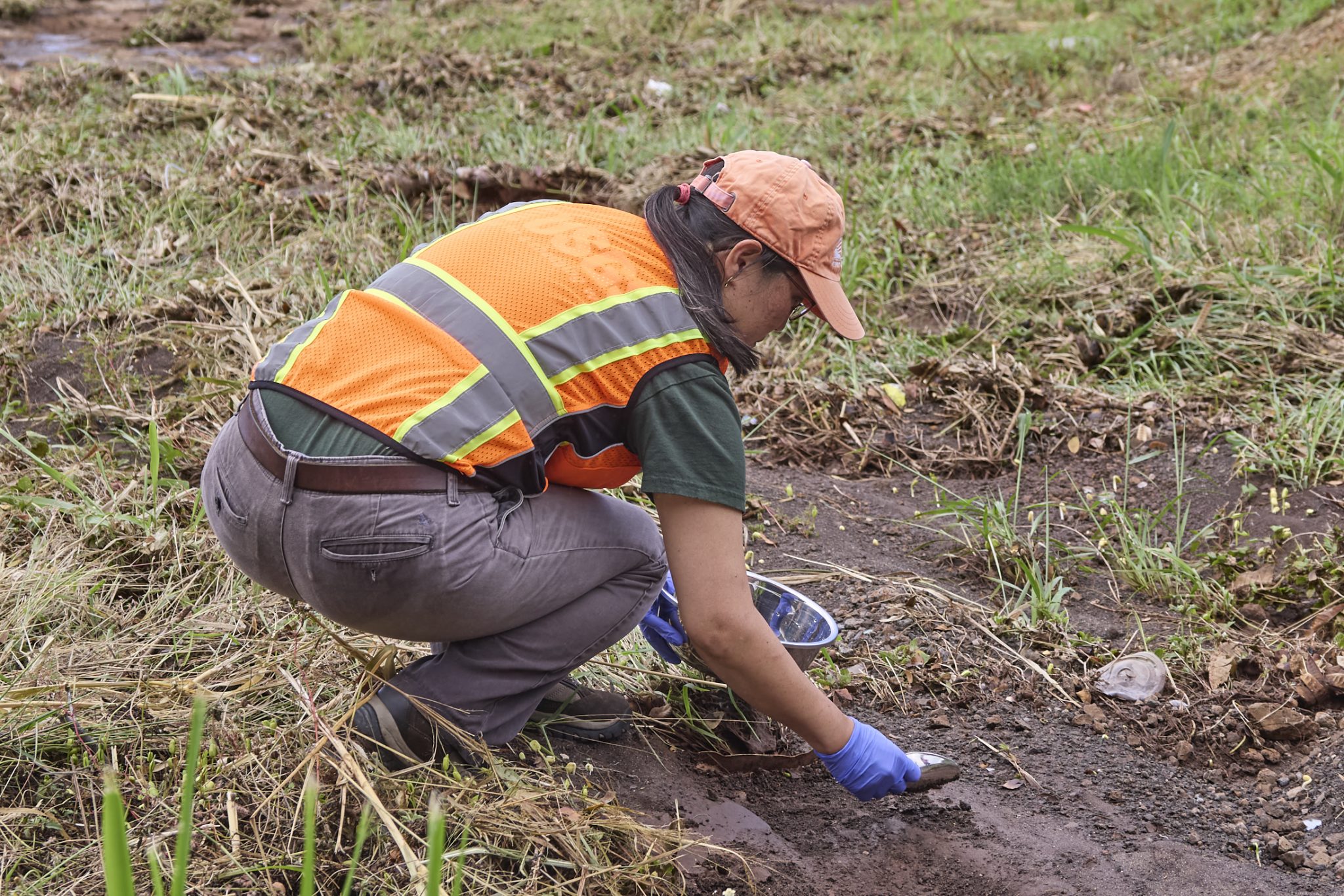

USGS scientist Renee Takesue collected sediment in a drainage ditch in Lahaina’s burn zone. Samples are being analyzed by independent labs to ascertain the levels of toxins present and to provide data to help guide remediation efforts in Lahaina. (David Croxford/Civil Beat/2024)
Scientists, state officials and the Army Corps of Engineers are finding the burn zone may not be as toxic as initially feared.
On a sun-drenched January morning, Renee Takesue got down on her hands and knees to dig in Lahaina’s dirt.
The federal research geologist filled containers with soil taken from the mouth of a culvert near the post office. She then crossed Honoapiilani Highway and filled jars with ocean water.
Takesue is looking for harmful contaminants resulting from the Aug. 8 wildfire, things like dioxins, heavy metals, flame retardants and forever chemicals found in firefighting foams and household products.
Her work at 28 sites on land and 10 in the ocean is part of a multi-agency and community effort to understand how the deadly wildfire affected the environment.
It’ll be some time before final conclusions are drawn but early results are encouraging and could hasten Lahaina’s recovery. Just last week state health officials said the ocean around Lahaina is safe for recreation.
Ironically, the preliminary positive news may stem from the fire’s unique alchemy.
Wind-whipped flames that tore through Lahaina on Aug. 8 created an urban fire so hot it not only melted glass, but it appears to have resulted in the complete combustion of many chemicals, rendering them inert.
“The dioxins were not even at levels of concern despite this being a town that burned down,” Takesue said last week.
Molten glass found after the blaze suggests temperatures exceeded 2,700 degrees Fahrenheit. That’s higher than waste incinerators, which usually burn at between 1,800 and 2,200 degrees, according to the U.S. Environmental Protection Agency.
“What happens is that the chemicals either totally volatilize and get transported through the atmosphere or they get destroyed because the temperature is so high,” the U.S. Geological Survey scientist said.
The latest scientific findings mark a big shift from the early days after the fire when many feared that toxins released from burned buildings, cars, boats, gas stations, electrical transformers and fallow agricultural lands may have left behind a dystopian landscape of cancer-causing poisons.
The Lahaina fire killed at least 101 people, destroyed more than 2,200 structures and scorched nearly the same number of acres, many of them former agricultural and grasslands laden with pesticide and herbicide residue.
Many feared runoff would wash into the ocean, contaminating fish and killing the coral reef. The EPA scrambled to spray Soiltac, a soil tackifier, on the toxic ash to keep it in place. Contractors from the Army Corps of Engineers placed absorbent straw tubes around drains to prevent stormwater from entering the sea.
While the data that’s come in offers reason for hope, scientists involved in the monitoring effort say continued sampling and long-term studies are crucial.
Takesue, a California-based researcher, is essentially a scientific detective. Her job is to find out not only what the wildfire left behind as far as environmental contamination, but to distinguish it from pre-fire sources.
The results of her ridge-to-reef sampling get shared with […]
Full article: www.civilbeat.org
Clean water is essential for life, yet millions of Americans unknowingly consume contaminants through their…
Human brains contain higher concentrations of microplastics than other organs, according to a new study, and the…
From the Office of the Governor: In anticipation of a multi-day, significant atmospheric river in Northern California,…
From Governor Newsom: Scientists, water managers, state leaders, and experts throughout the state are calling…
Photo: A harmful algal bloom in Milford Lake, Kansas, made the water appear bright green.…
An expanded plastic foam coffee cup is at a donut shop in Monterey Park, California.…